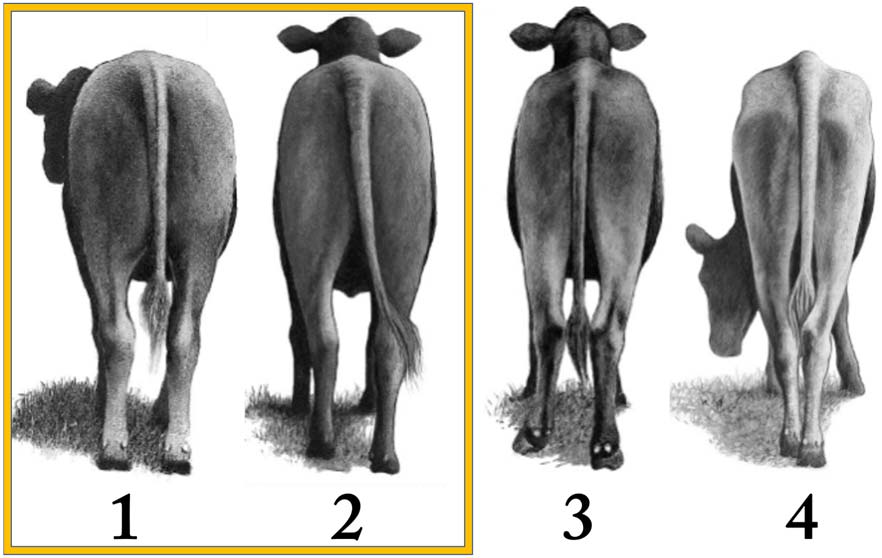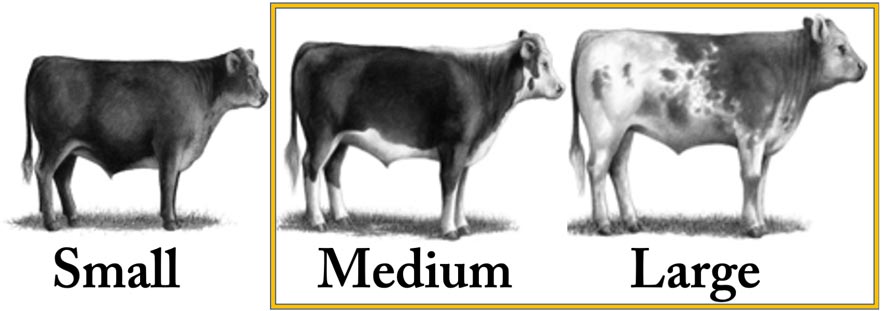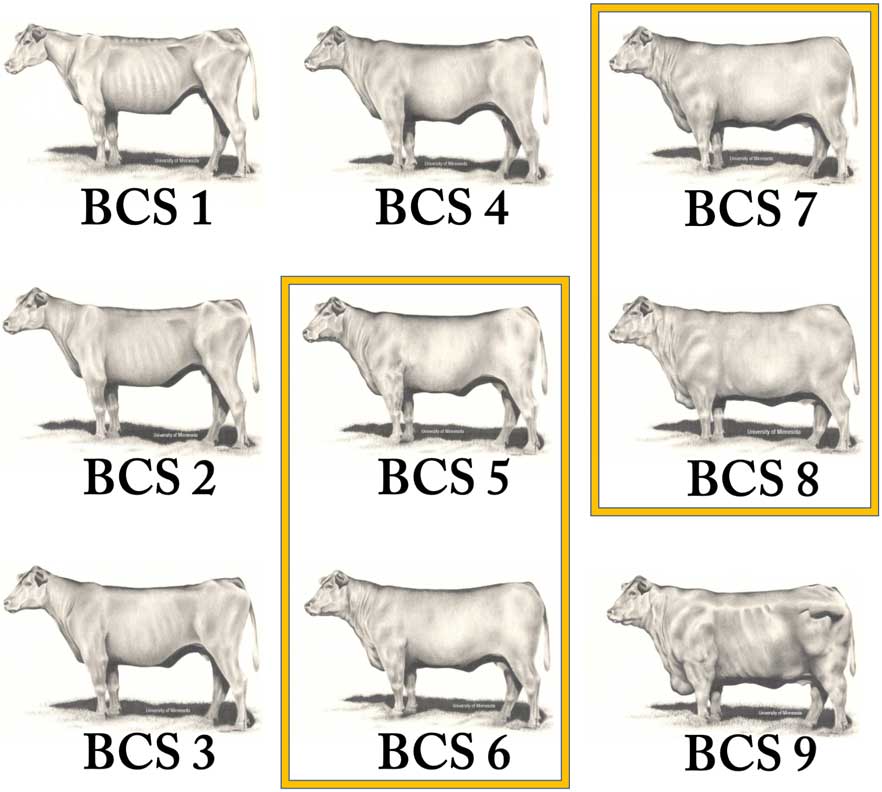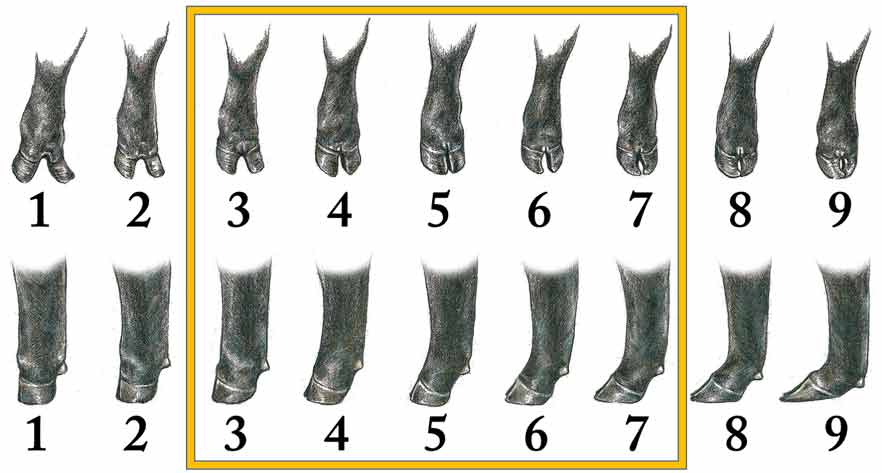
Screening of replacement heifers is a critical management practice for both commercial and seedstock beef cattle operations. The Missouri Show-Me-Select Replacement Heifer Program (Figure 1) is an on-farm heifer development and marketing program that has improved the quality of replacement heifers in the state of Missouri and around the country. Program standards are designed to ensure beef producers are offered valuable replacement females that will continue to be profitable throughout their lifetime. This is accomplished not only through management requirements relative to breeding practices, but also meticulous screening and selection criteria for health, genetics, and conformation.
To receive a Show-Me-Select ear tag and be eligible for sale as a Show-Me-Select heifer, a heifer must possess an adequate amount of muscling and frame, have a healthy body condition score, possess a sound foot shape and leg conformation, and have a tolerable disposition. Each of these characteristics positively correlates to the heifer’s reproductive success and overall profitability in the future. Show-Me-Select heifers selling through sanctioned Show-Me-Select sales must also lack blemishes and be in good health at the time of sale. This MU Extension guide is provided as a resource to aid in screening replacement heifers, with particular attention to the screening process and standards for heifers enrolled in the Missouri Show-Me-Select Replacement Heifer Program.
Screening process in the Show-Me-Select replacement heifer program
Although the marketing of heifers is an important component of the Show-Me-Select Replacement Heifer Program, the program is educational at its core. The Show-Me-Select standards are designed as a “Black and Gold Standard” that producers of all replacement heifers should consider when making selection and screening decisions. First and foremost, producers enrolling heifers in the Show-Me-Select Replacement Heifer Program are encouraged to take ownership of this process and closely evaluate their own heifers throughout the course of the development program. Setting a high personal and professional standard for the quality of heifers marketed will build consignors’ reputation among repeat buyers and ultimately improves the quality of the U.S. beef herd.
University of Missouri Extension livestock field specialists also play an important role in the Show-Me-Select program, as do participating veterinarians from around the state. These personnel are a source of helpful guidance relative to management decisions and will also screen heifers based on program requirements. In the Show-Me-Select Replacement Heifer Program timeline, an initial screening of heifers takes place at the time of the prebreeding exam. Heifers will also be screened at pregnancy diagnosis and/or at the time of tagging. If a heifer does not meet program standards based on the judgement of a University of Missouri Extension livestock field specialist, the heifer will not be eligible to receive a Show-Me-Select ear tag.
Lastly, at officially sanctioned Show-Me-Select sales, graders from the Missouri Department of Agriculture evaluate each heifer based on the program standards. As an independent third party, all decisions by Missouri Department of Agriculture graders relative to a heifer’s program eligibility are final. In the event that a heifer is deemed ineligible for consignment in a Show-Me-Select sanctioned sale, the Show-Me-Select ear tag will be removed. Consignors will take these heifers home from the sale or arrange other marketing opportunities, with the understanding that the heifer may not be marketed using the Show-Me-Select trademark. Ultimately, this is to maintain the integrity of the program and protect both buyers and sellers.
Muscling and frame standards
From a muscling standpoint, Show-Me-Select heifers must be a No. 1 or No. 2 on the USDA 4-point Muscling Thickness Scale (Figure 2), with No. 1 being the thickest muscling cattle and No. 4 being the thinnest muscling cattle. In layman’s terms, these heifers should be thrifty, round throughout their back and loin, and possess a decent amount of width off both ends. Their muscling pattern ideally will be long, smooth, and of moderate thickness. As a reference, a typical finished or “fat” steer of a beef background will have a muscle score of No. 1.

Projected frame size is evaluated using the USDA Frame Scoring system (Figure 3). Projected frame size is evaluated as small, medium, or large frame scores. Frame score provides an indication about the weight range heifers would be estimated to reach at maturity. In the Show-Me-Select Replacement Heifer Program, heifers must be at least a medium frame score. A frame score of large also qualifies. However, very small frame heifers with a projected weight of less than 1000 lbs at maturity are currently not eligible for the program.

Weight and condition
Heifers marketed through sanctioned Show-Me-Select sales must weigh at least 800 lbs at the time of sale. However, weight alone does not guarantee a heifer’s eligibility. Condition of heifers is critical to ensure animal health and productivity after calving, as well as to provide greater likelihood of future reproductive success. Data points towards lower pregnancy rates and longer calving intervals in cattle with a Body Condition Score (BCS) of less than 5. In the Show-Me-Select program, heifers are encouraged to be marketed at a BCS of 6 to 7 and are required to score between 5 and 8 on the 9-point BCS scale (Figure 4). Note that this range of body condition scores requires ribs to be covered by at least a thin layer of fat. Heifers that are BCS 4 or below will not be eligible for consignment in a sanctioned sale, nor will heifers that are BCS 9. For more guidance on body condition scoring and a more detailed description of the body condition scores, see MU Extension publication G2230, Body Condition Scoring of Beef Cattle.

Feet and leg conformation
Foot shape and set is a characteristic of high importance to commercial producers, and several breed associations are beginning to place even greater emphasis on selection for this economically relevant trait in the seedstock sector. Foot structure of heifers is extremely important, as it substantially impacts a heifer’s longevity within the herd.
Foot scoring (Figure 5) involves assessment of both the hoof claw shape and the hoof set angle. Both measurements are based on a 9-point scale, with 5 being ideal. Hoof claw shape indicates the size and curve of each claw, along with the distance between the two. Females with small, uneven, or curled toes are more likely to become lame later in life. Ideally, heifers should have symmetrical claws with an appropriate amount of space between them. Hoof angle measures the degree of angularity of the pastern, with a 45-degree angle being desirable. This allows for adequate heel depth and toe length, without the female being too straight in her pasterns. While scoring may seem subjective, foot scoring is very useful and repeatable among experienced evaluators of foot structure. When evaluating their own heifers, producers are advised that Show-Me-Select heifers should have a foot claw shape of 3 to 7 and a hoof set angle from 3 to 7 on all feet. This minimizes potential that foot structure will be deemed unacceptable by the livestock field specialist at tagging or by the grader during the pre-sale screening.

In addition to foot shape and set, leg conformation will also be evaluated. Heifers are not required to have flawless conformation. However, conformation that results in uncoordinated, slow movement of the animal or a stiff, restricted range of motion is not acceptable. Therefore, heifers that are severely post-legged, splay-footed, sickle-hocked, knock-kneed, or bucked-kneed will not be eligible for consignment in a sanctioned Show-Me-Select sale.
Producers are encouraged to evaluate the foot and leg structure of their heifers independently beginning at yearling age and to seek input from their livestock field specialist and/or veterinarian. Foot and leg structure is difficult to assess except on dry surfaces free of mud, bedding, or excessive plant material. Repeated evaluation of animals and encouraging light movement of the animals during the evaluation process usually results in the most realistic assessment. Ultimately, a heifer with poor foot and leg structure may be deemed ineligible to receive a Show-Me-Select ear tag at the discretion of the extension livestock field specialist. Additionally, if foot or leg structure is deemed unacceptable by a grader during the pre-sale screening, heifers will be ineligible for consignment and the Show-Me-Select tag must be removed.
Blemishes and health
Heifers with permanent blemishes or deformities will not be eligible to receive a Show-Me-Select tag, or must have the Show-Me-Select tag removed following the pre-sale screening. Examples of permanent blemishes that disqualify females from consignment in Show-Me-Select sales include scarred eyes, frozen ears, rat-tails, bob-tails, or other deformities.
Impermanent blemishes or transient health problems observed during the pre-sale screening will not result in removal of the Show-Me-Select ear tag, but heifers will not be eligible for consignment in the sanctioned sale. Likewise, active health issues such as pink eye, foot rot, ringworm, warts, or respiratory disease will disqualify heifers. An open wound that could become a source of infection will also disqualify heifers from consignment in a sanctioned sale. Horns must also be removed, and any scurs longer than 2 inches in length must also be removed per program requirements. Scars from horn or scur removal must be fully healed by sale day.
Minor cosmetic blemishes are understood to occur among a small percentage of cattle, sometimes even as a result of using good management practices. Minor blemishes will not result in disqualification of heifers from tagging or consignment to a sanctioned sale. For example, a split ear resulting from an ear tag being torn is not considered a significant blemish and will not result in disqualification. Likewise, a small knot/lump at a previous vaccination site is not a significant blemish, unless its appearance or size is otherwise concerning (e.g. golf-ball-sized or larger in size or appearing abscessed).
Disposition
Disposition and temperament of beef females is an economically relevant trait, and screening for disposition minimizes the chance of future injury, damage to facilities, or poor animal performance. Disposition varies from animal to animal, and the importance of disposition will vary among individual producers based on their expectations. Show-Me-Select heifers are not required to be exceptionally calm; however, dangerously flighty or aggressive behavior is not acceptable.
Disposition of heifers should be monitored by the producer individually during the development process. In addition, the extension livestock field specialist and/or veterinarian will note if a heifer exhibits aggressive or exceptionally flighty behavior during handling. Heifers with very poor dispositions will not receive Show-Me-Select ear tags at tagging. Likewise, if a heifer exhibits poor disposition during the screening process prior to a sanctioned Show-Me-Select sale, this could result in disqualification by a grader and removal of the Show-Me-Select ear tag.
Hair shedding
Although not formally required in the Show-Me-Select Replacement Heifer Program, heifers are strongly suggested to be evaluated for shedding of the winter hair coat. This genetically heritable trait is correlated with a female’s thermoregulatory capacity or susceptibility to heat stress. Early hair shedding corresponds to better adaptation to the production environment, which can be especially important in environments where cattle graze pastures that are predominately endophyte-infected tall fescue. Early hair shedding can positively affect reproduction and eventual progeny performance, especially in hot and humid climates. Cattle that handle hot and humid stress better will ultimately be more productive and therefore potentially more profitable.
Hair-shedding scores are a visual measurement of the extent to which the winter hair coat is shed by the late spring or early summer. This measurement is suggested to be taken when the group of animals shows the most variation in shedding. For most producers in Missouri, this would be early- to mid-May. Hair-shedding scores range from 1 to 5. A hair score of 1 corresponds to a slick, short hair coat, or an animal that has completely shed their winter coat. A hair score of 5 corresponds to 0% shed, or an animal who still has a full winter coat. Cattle do not need to be restrained to collect this data. This can be measured by observing cattle out on pasture or in conjunction with a working event.
For more information on hair shedding and for example images of hair shedding scores, refer to MU Extension publication G2014, Hair Shedding Scores: A Tool to Select Heat Tolerant Cattle.
Pelvic area and reproductive tract score
A prebreeding reproductive evaluation is required for all heifers and must be performed 30 to 60 days prior to breeding. Pelvic measurement (height and width in square centimenters) and a reproductive tract score (1-5 scale) is required for each heifer at this time. Heifers must have a minimum pelvic area of 150 cm2. Heifers with a pelvic area smaller than 150 cm2 may be re-measured at the initial pregnancy exam, performed within 90 days from the start of the breeding season. At that time, heifers that are re-measured must have a minimum pelvic area of 180 cm2 to qualify. No reproductive tract score minimum is required; however, producers are encouraged to cull heifers with reproductive tract score of 1 due to their poor likelihood of becoming pregnant early in the breeding period. For more guidance on using prebreeding information in the selection and management of replacement heifers, see MU Extension publication G2028, Selection of Replacement Heifers for Commercial Beef Cattle Operations.
Pregnancy determination
An initial pregnancy examination must be performed within 90 days from the start of the breeding season. Individual animal identification, pregnancy status and fetal age (in days) are required. Reporting of fetal sex is optional. A confirmatory pregnancy examination must be performed within 30 days prior to sale. Any heifer that fails to become pregnant, or loses a pregnancy following the original breeding season, is no longer eligible for the program.
Overview and FAQ

An overview of the timeline for screening and data collection is provided in Figure 6. Some frequently asked questions (FAQ) are as follows:
If a heifer is deemed ineligible to receive a Show-Me-Select ear tag or is screened out prior to an officially sanctioned sale, may she still be marketed private treaty in a person-to-person transaction?
Because the phrase “Show-Me-Select” is a registered trademark, a heifer may not be advertised or marketing using this phrase unless that heifer has an official Show-Me-Select ear tag. Therefore, this phrase should not be used in marketing of any heifers that were deemed ineligible to receive a Show-Me-Select tag or whose Show-Me-Select tag was removed as a result of being screened out of a sanctioned sale.
Why are small-frame cattle discriminated against by the Show-Me-Select Replacement Heifer Program standards?
Understanding that moderate frame cattle can be very profitable in some beef production contexts, frame is assessed in very loose terms in the Show-Me-Select Replacement Heifer Program. For the purposes of this program, therefore, standards do allow very moderate frame heifers to be tagged and marketed as Show-Me-Select heifers. For example, “medium frame” is defined fairly broadly, so as to permit heifers with a projected mature weight as low as 1000 lbs. Given the need for some level of consistency among heifers marketed through the program and understanding the type and kind sought by buyers of Show-Me-Select heifers, program standards do not allow heifers of very small frame to receive a Show-Me-Select ear tag. Producers of very small frame cattle may enroll heifers in the program but are encouraged to explore alternative value-added marketing opportunities.
Why are blemishes like frozen ears a basis for heifers to be ineligible? Does that really matter?
Many blemishes are indeed cosmetic and do not meaningfully affect potential for commercial productivity. However, heifers marketed as Show-Me-Select must be free from deformities like frozen ears partly in order to best represent the quality for which the program has come to be recognized. Screening is also increasingly important as growing numbers of heifers are purchased via online auction platforms incorporated into the sale, and prospective buyers do not always have the opportunity to adequately evaluate animals prior to sale.
Graders will ensure that heifers consigned to sanctioned Show-Me-Select sales are free from blemishes. Extension livestock field specialists may also deem blemished heifers ineligible to receive a Show-Me-Select ear tag. In most cases, this would only occur if the blemish impacts commercial productivity or if the blemish is substantial enough so as to reflect poorly on the Show-Me-Select program as a whole. Due to the broad and widely variable nature of blemishes, these decisions are left solely to the discretion of the extension livestock field specialist.
Can heifers’ feet be trimmed so that structural problems are corrected prior to sale?
Hoof trimming of prospective Show-Me-Select heifers is strongly discouraged. Ideally, extension field specialists should have the opportunity to assess heifers’ inherent foot and leg structure when evaluating heifers prior to tagging. Likewise, both the grader and prospective buyers should have the opportunity to evaluate inherent foot and leg structure prior to a sale.
Is there an appeal process for heifers that are screened out of the Show-Me-Select Replacement Heifer Program?
The Missouri Show-Me-Select Replacement Heifer Program is a 501(c)3 organization that relies heavily on University of Missouri Extension and the Missouri Department of Agriculture for guidance and support. With the understanding that Missouri Department of Agriculture graders and University of Missouri Extension livestock field specialists are experts in their field and are independent third parties, these individuals serve as the final decision-makers relative to heifers’ eligibility. Producers are encouraged to view disqualification of heifers as just one step in the process toward improving the quality of replacement heifers they produce. Concerns about the decisions made during the screening process can be directed to Dr. Jordan Thomas, University of Missouri state cow-calf extension specialist: 573-882-1804 or thomasjor@missouri.edu.
Summary
Ultimately, the screening process for heifers in the Show-Me-Select Replacement Heifer Program ensures buyers have the opportunity to purchase reliable, high-quality heifers with potential for a long, productive lifetime. In addition to maintaining the standard of excellence for which the Show-Me-Select brand has come to be known, these standards provide an example to the commercial and seedstock sectors of the beef industry relative to selection and screening criteria appropriate for all replacement females. For more information on enrolling heifers in the Show-Me-Select Replacement Heifer Program, visit the Show-Me-Select webpage at extension.missouri.edu or contact the MU Extension livestock field specialist in your region.